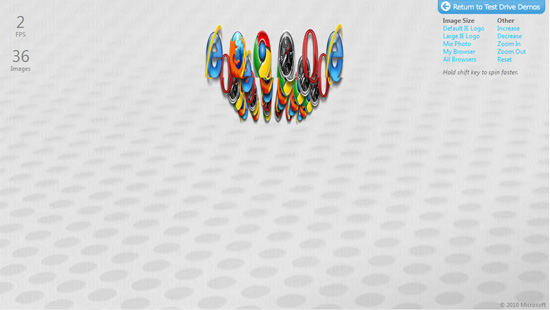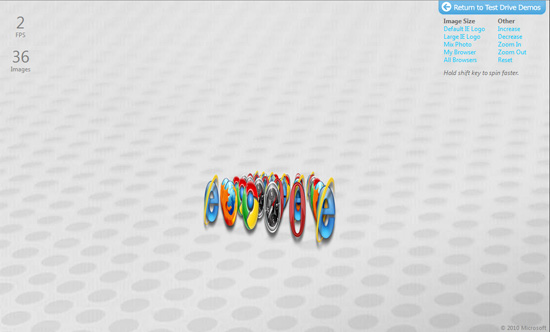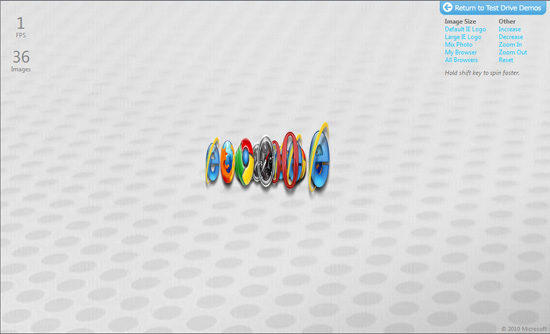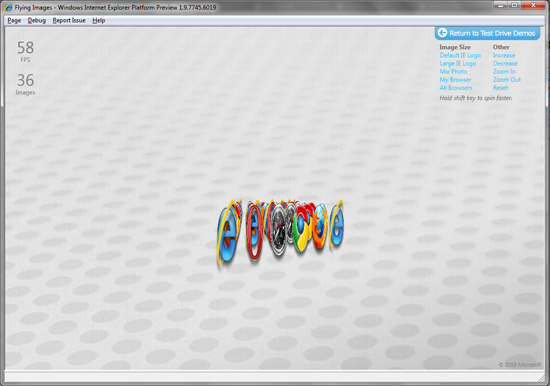Internet Explorer 9 Platform Preview: Investigated
by Brian Klug on March 17, 2010 11:44 AM EST- Posted in
- Trade Shows
GPU Accelerated HTML5
The strongest bid IE 9 is trying to make against its competitors is that of superior, GPU-driven performance. For quite some time, the bar has been steadily raised in the JavaScript engine domain by continual competing releases of Chrome, Firefox, and Opera. However, HTML5 <video> asset tags mean that (should the standard catch on) browsers themselves (rather than plug-ins) will be a huge contributing factor for playback performance. Microsoft showed a rather compelling demo with two GPU-accelerated videos simultaneously playing back in the browser on a (ostensibly ION-based) netbook with minimal to no stutter. Surprisingly, HTML5 <video> is not enabled in the consumer preview out now. Microsoft offers a relatively curt explanation why:
"The demo of HTML5 <video> at MIX10 was a preview of a future release of the Platform Preview."
It's likely that there still are GPU vendor-specific issues that need to be worked on before they're comfortable releasing a build with support. Until then, it's impossible to really know how IE 9 HTML5 video playback stacks up against Chrome and Firefox's implementations.
In addition, they showcased the subpixel-rendering capabilities that they can leverage that other browsers still lack.
But the big performance boon comes for both 2D and 3D HTML5 display acceleration. One of the demos given the most stage presence during the keynote consisted of a grid of spinning browser logos nicknamed "spinning images." It represents what Microsoft considers an ideal showcase for the dramatic performance increases possible with GPU accelerated graphics in-browser. I went ahead and decided to run my own tests across a number of browsers. Pay attention to image quality as well.

First up is IE 8, which struggled to render a mere 1-2 FPS. You can see the banding which was evident virtually the entire time. Image quality, however, is good.

Next up is Safari 4.0.4. Image quality of the scaled logos in the extreme back and far front is likewise very good, however Safari too struggles to render more than 2-3 FPS.

Next, Firefox 3.6. Performance here is dramatically better than Safari or IE 6, however look at the images in the extreme background and extreme foreground. There's obvious image-degrading nearest-neighbor downsampling going on, resulting in horribly blocky logos. Performance is more than acceptable, but comes at the price of quality.

Chrome's performance is surprisingly bad given its stellar reputation for performance, but unsurprising given the poor performance of its WebKit brethren, Safari. Again, image quality is very good, likely at the cost of performance.

Finally, IE 9 Platform Preview gives the highest performance yet, at around 58-60 FPS. At the same time however, image quality sits somewhere between Firefox 3.6 and Safari/Chrome/IE 8. It's obvious that there's some downsampling here that isn't 100% quality-friendly, however, there's significantly less blocking. Detail is still a bit strange inside the black Safari logo.
Obviously, we have to take these results with a bit of skepticism; the IE team has had the time to optimize their platform preview to the technology demo they saw think shows off their platform best. That said, there are clear and obvious performance benefits to be had from GPU acceleration in the browser.
It hasn't been made entirely clear what system requirements are necessary for GPU accelerated content, however, they're apprently enough to completely preclude Windows XP from running IE 9 platform preview. Integration is likely tied to Windows Display Driver Model (WDDM) given the strict Windows Vista (with a platform update) or Windows 7 requirement.
Final Words
Whatever the case, it's obvious that Microsoft has heard developers plea for improved standards compliance and dramatic performance improvements across what remains the world's largest browser platform. Microsoft has been acting a lot like Google or Apple lately, evidenced through an open feedback platform preview such as IE 9, and showing an awareness for the seriousness of both its competitors browser and mobile device offerings.










60 Comments
View All Comments
Sahrin - Wednesday, March 17, 2010 - link
Why would MS announce their colossal failure on Acid3 and then tweak to optimize for the GPU accelerated animation test?JonnyDough - Wednesday, March 17, 2010 - link
Dear Microsoft:We don't want you to control our computers. We want STANDARDS to control how our computers operate. STANDARDS that make things flow well and work together. Stop re-writing your crappy browser the way you know how and LEARN how to write it CORRECTLY, according to the standards that the industry has put in place. Error loading webpage alerts are not fun. K? Thnx. Bye bye.
DominionSeraph - Wednesday, March 17, 2010 - link
Yes, Microsoft; take your DirectX and shove it.And your .avi container? What a colossal failure that has been. I'd much rather have the industry standard .mp4, because it's not like that's just Apple's .mov or anything. Or as if .mkv is superior.
And Phil Katz's .zip? No! STANDARDS I say! LEARN how to write it CORRECTLY, according to the standards that the industry has put in place. That standard being.... uhhhhh.... never mind. Everyone just uses .zip as laid out in PKWARE's appnote.txt.
And filename extensions? GTFO. Because it's not like you just read this post.
Nataku - Wednesday, March 17, 2010 - link
what in the h*** is the wrong with you... you didn't read the article did you?I wonder if this new browser will use dual gpu configurations well.
lotharamious - Wednesday, March 17, 2010 - link
I think that ball's is in Nvidia's and ATI's court.pvdw - Wednesday, March 17, 2010 - link
It's been years since I've used IE as my main browser, but whether or not I choose to change, competition is great news for us - the users!This reminds me of Netscape's heyday, before MS killed them and progress stagnated till Opera/FF/Safari.
qwertymac93 - Wednesday, March 17, 2010 - link
i ran the flying images test and i got 16fps on opera 10.5 with 256 images, chrome could barely manage 2 fps with 64. firefox managed 6fps with 256 images, but apparently wasn't applying the gaussian blur filter it was supposed to, leading to jagged edges, this is probably why it performs so well...screens of opera, ff, and chrome(in that order)
http://img146.imageshack.us/img146/6881/98089180.j...">http://img146.imageshack.us/img146/6881/98089180.j...
http://img707.imageshack.us/img707/6569/30885682.j...">http://img707.imageshack.us/img707/6569/30885682.j...
http://img532.imageshack.us/img532/8895/29131277.j...">http://img532.imageshack.us/img532/8895/29131277.j...
chrome had the best quality, opera lower quality but much better speed(chrome was actually lower then 1fps), and firefox had the worst of both worlds, even worse quality then opera and one third the speed.
qwertymac93 - Wednesday, March 17, 2010 - link
i forgot to mention, opera had a weird flickering issue that turned half the screen dark gray every now and then. you can clearly see it in the screen.SpeedMan88 - Wednesday, March 17, 2010 - link
I played around with this test and, as suspected, found that my graphics card driver settings such as anti aliasing, anisotropic filtering, and mipmap quality levels affected the quality of the rendered images. You should be able to get near perfect image quality by cranking up the quality in your graphics card drivers. Forcing 16x AF seemed to make the biggest difference for me.Lazlo Panaflex - Wednesday, March 17, 2010 - link
"and claims it's at party with Firefox 3.6"Yeah baby. Like it's 1999.
;)